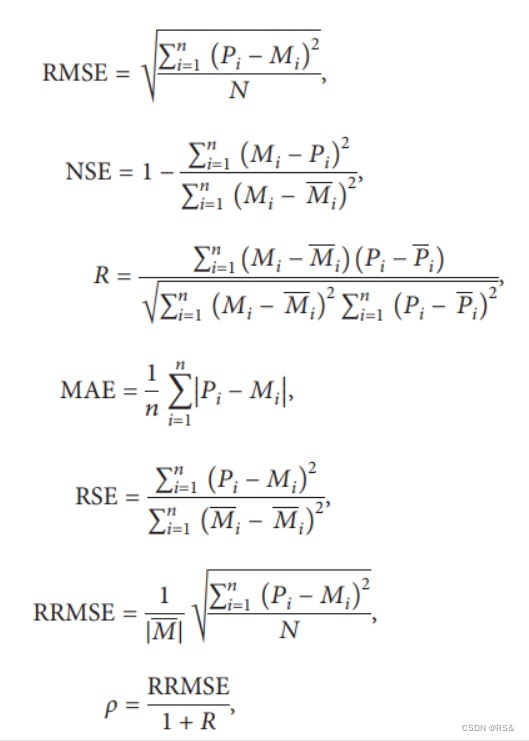0、各项回归指标简介
- Relative Root Mean Squared Error(RRMSE):The RRMSE normalizes the Root Mean Squared Error (RMSE) by the mean of observations. It goes from 0 to infinity. The lower the better the prediction performance.
- The NRMSE(Normalized Root Mean Square Error) is calculated as the RMSE divided by the range of the observed values, expressed as a percentage. The range of the observed values is the difference between the maximum and minimum values of the observed data.
Best possible score is 0.0, smaller value is better. Range = [0, +inf) - MAE (Mean absolute error) represents the difference between the original and predicted values extracted by averaged the absolute difference over the data set.
- MSE (Mean Squared Error) represents the difference between the
original and predicted values extracted by squared the average
difference over the data set. - RMSE (Root Mean Squared Error) is the error rate by the square root
of MSE. - R-squared (Coefficient of determination) represents the coefficient
of how well the values fit compared to the original values. The value
from 0 to 1 interpreted as percentages. The higher the value is, the
better the model is.
1、Python计算回归拟合各项指标:包括RMSE # RRMSE # RSE # NSE # MAE # R # R2 # MAPE # ρ

图片来源:https://github.com/alifrmf/Evaluation-Metrics-for-Linear-Regression/blob/main/README.md
代码:
# RMSE
def rmse(y_true, y_pred):squared_diff = (y_true - y_pred) ** 2mean_squared_diff = np.mean(squared_diff)rmse_value = np.sqrt(mean_squared_diff)return rmse_value
RRMSE计算方式一:RMSE除以真实值的均值
# RRMSE(Relative Root Mean Squared Error )
def rrmse(y_true, y_pred):# Calculate the squared errors between the predicted and true valuessquared_errors = (y_true - y_pred) ** 2# Calculate the mean of the squared errorsmean_squared_error = np.mean(squared_errors)# Take the square root of the mean squared errorroot_mean_squared_error = np.sqrt(mean_squared_error)# Calculate the relative error by dividing the root mean squared error by the mean of the true valuesrelative_error = root_mean_squared_error / np.mean(y_true)# Return the RRMSE valuereturn relative_error
RRMSE计算方式二:除以真实值最大值-真实值最小值
def rrmse(s, o):"""Relative Root Mean Squared Errorinput:s: simulatedo: observedoutput:relative root mean squared error"""return 100*np.sqrt(np.mean((s-o)**2))/(o.max()-o.min())
# RSE
def root_squared_error(y_true, y_pred):"""Calculate the Root Squared Error between two arrays (y_true and y_pred).Args:y_true (numpy.ndarray): Actual values.y_pred (numpy.ndarray): Predicted values.Returns:float: The Root Squared Error."""error = y_true - y_predsquared_error = np.square(error)mean_squared_error = np.mean(squared_error)root_squared_error = np.sqrt(mean_squared_error)return root_squared_error
# NSE
def nash_sutcliffe_efficiency(y_true, y_pred):"""Calculate the Nash-Sutcliffe Efficiency (NSE) between two arrays (y_true and y_pred).Args:y_true (numpy.ndarray): Actual values.y_pred (numpy.ndarray): Predicted values.Returns:float: The Nash-Sutcliffe Efficiency."""numerator = np.sum(np.square(y_true - y_pred))denominator = np.sum(np.square(y_true - np.mean(y_true)))nse = 1 - (numerator / denominator)return nse
# MAE
def mean_absolute_error(y_true, y_pred):"""Calculate the Mean Absolute Error (MAE) between two arrays (y_true and y_pred).Args:y_true (numpy.ndarray): Actual values.y_pred (numpy.ndarray): Predicted values.Returns:float: The Mean Absolute Error."""absolute_error = np.abs(y_true - y_pred)mae = np.mean(absolute_error)return mae
# R
def pearson_correlation_coefficient(y_true, y_pred):"""Calculate the Pearson Correlation Coefficient (R) between two arrays (y_true and y_pred).Args:y_true (numpy.ndarray): Actual values.y_pred (numpy.ndarray): Predicted values.Returns:float: The Pearson Correlation Coefficient."""correlation_matrix = np.corrcoef(y_true, y_pred)r = correlation_matrix[0, 1]return r
# R2
def r_squared(y_true, y_pred):"""Calculate the R squared value between two arrays (y_true and y_pred).Args:y_true (numpy.ndarray): Actual values.y_pred (numpy.ndarray): Predicted values.Returns:float: The R squared value."""correlation_matrix = np.corrcoef(y_true, y_pred)correlation_xy = correlation_matrix[0,1]r_squared = correlation_xy**2return r_squared# ρ (RRMSE / (1 + R))
def relative_rmse(y_true, y_pred):rmse = np.sqrt(metrics.mean_squared_error(y_true, y_pred))return rmse / (np.max(y_true) - np.min(y_true))def pearson_correlation_coefficient(y_true, y_pred):correlation_matrix = np.corrcoef(y_true, y_pred)r = correlation_matrix[0, 1]return r
代码来源:https://github.com/alifrmf/Evaluation-Metrics-for-Linear-Regression/blob/main/Regression%20Metrics%20for%20Machine%20Learning.py
2、Python计算bias、rbias、mae、rmse等指标
代码来源:https://github.com/dsi-llc/scripts/blob/d4445ef02a971754fdaef901250b42b8394539fa/EEstatslib.py#L80
import numpy as np# ------------------------------------------------------------------------------
# statistic functions
# ------------------------------------------------------------------------------def drop_nan(df):"""this function reads in dataframe after using dffromdatfile function in dataFrameFromdatfiles.pythen returns a dataframe without nan """df_dropped = df.dropna()return df_droppeddef data_paired(df):"""this function return the number of data pairedafter dropping nan values"""return df.shape[0]def bias(s, o):"""Biasinput:s: simulatedo: observedoutput:bias"""return np.mean(s-o)def rbias(s, o):"""Relative Biasinput:s: simulatedo: observedoutput:relative bias"""return 100*(np.sum(s-o))/np.sum(o)def mae(s, o):"""Mean(Average) Absolute Errorinput:s: simulatedo: observedoutput:mean absolute error"""return np.mean(np.abs(s-o))def rmse(s, o):"""Root Mean Squared Errorinput:s: simulatedo: observedoutput:root mean squared error"""return np.sqrt(np.mean((s-o)**2))def rrmse(s, o):"""Relative Root Mean Squared Errorinput:s: simulatedo: observedoutput:relative root mean squared error"""return 100*np.sqrt(np.mean((s-o)**2))/(o.max()-o.min())def correlation(s, o):"""Correlation Coefficientinput:s: simulatedo: observedoutput:correlation coefficient"""return np.corrcoef(o, s)[0, 1]def r_sqr(s, o):"""R Squared (Square of Correlation Coefficient)input:s: simulatedo: observedoutput:R Squared""" return correlation(s, o)**2def nsi(s, o):"""Nash-Sutcliffe Index of Efficiencyinput:s: simulatedo: observedoutput:nash-sutcliffe index of efficiency"""return 1-np.sum((s-o)**2)/np.sum((o-np.mean(o))**2)def coe(s, o):"""Coefficient of Efficiencyinput:s: simulatedo: observedoutput:coefficient of efficiency"""return 1 - np.sum(np.abs(s-o))/np.sum(np.abs(o-np.mean(o)))def ioa(s, o):"""Index of Agreementinput:s: simulatedo: observedoutput:index of agreement"""return 1 - (np.sum((o-s)**2))/\(np.sum((np.abs(s-np.mean(o))+np.abs(o-np.mean(o)))**2))def kge(s, o):"""Kling-Gupta Efficiencyinput:s: simulatedo: observedoutput:kgef: kling-gupta efficiencycc: correlationalpha: ratio of the standard deviationbeta: ratio of the mean"""cc = correlation(s, o)alpha = np.std(s)/np.std(o)beta = np.sum(s)/np.sum(o)kgef = 1 - np.sqrt((cc-1)**2 + (alpha-1)**2 + (beta-1)**2)return kgef, cc, alpha, betadef stats_summary(df, sim_column_idx=0, obs_column_idx=1, decimals=3):"""Statistics Summary, output all statistics number in dictionaryinput:df: dataframe from EE.dat file (default just two columns, model and data)sim_column_idx: column index for simulated values (default 0)obs_column_idx: column index for observed values (default 1)decimals: round all statistics to the given number of decimals (default 3)output:statsummary: dictionary with all statistics number"""df_drop = drop_nan(df)simulated = df_drop.iloc[:, sim_column_idx]observed = df_drop.iloc[:, obs_column_idx]statsummary = {'Data Paired': data_paired(df_drop),'Bias': np.round(bias(simulated, observed), decimals),'Percent Bias': np.round(rbias(simulated, observed), decimals),'Mean Absolute Error': np.round(mae(simulated, observed), decimals),'RMSE': np.round(rmse(simulated, observed), decimals),'RRMSE': np.round(rrmse(simulated, observed), decimals),'R': np.round(correlation(simulated, observed), decimals),'R-Sqr': np.round(r_sqr(simulated, observed), decimals),'Nash-Sutcliffe Efficiency': np.round(nsi(simulated, observed), decimals),'Coefficient of Efficiency': np.round(coe(simulated, observed),decimals),'Index of Agreement': np.round(ioa(simulated, observed), decimals),'Kling-Gupta Efficiency': np.round(list(kge(simulated, observed))[0], decimals)}return statsummary
)



前后端篇(四)(一步步实现+源码))






:变量声明let与const、箭头函数、模板字面量全面解析)

)





